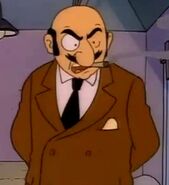No edit summary Tag: rte-wysiwyg |
No edit summary Tag: rte-wysiwyg |
||
| Line 37: | Line 37: | ||
Rastapopoulos.jpg|Rastapopoulos as seen in ''[[The Blue Lotus]]''.|link=Roberto Rastapopoulos |
Rastapopoulos.jpg|Rastapopoulos as seen in ''[[The Blue Lotus]]''.|link=Roberto Rastapopoulos |
||
Rastapapolus in film.jpg|Rastapopoulos in the film set.|link=Roberto Rastapopoulos |
Rastapapolus in film.jpg|Rastapopoulos in the film set.|link=Roberto Rastapopoulos |
||
| − | Rastapopolis in America.jpg|Rastapopoulos as seen in ''[[Tintin in America]]''.|link=Roberto Rastapopoulos |
||
Roberto rastapopoulos.jpg|link=Roberto Rastapopoulos |
Roberto rastapopoulos.jpg|link=Roberto Rastapopoulos |
||
Rastapopolis.png|Rastapopoulos was talking on the phone to one of his agents.|link=Roberto Rastapopoulos |
Rastapopolis.png|Rastapopoulos was talking on the phone to one of his agents.|link=Roberto Rastapopoulos |
||
| + | Roberto J. Ratapopoulos.PNG |
||
</gallery> |
</gallery> |
||
==Trivia== |
==Trivia== |
||
Revision as of 18:49, 3 June 2015
Roberto Rastapopoulos (Greek: Ροβέρτος Ρασταπόπουλος, Robert Rastapopoulet) is a recurring character in The Adventures of Tintin series of comic books drawn and written by Hergé. He is Tintin's archenemy, and plays the role of the antagonist in much of the Tintin series. Rastapopoulos is a Greek-American who unlike some other characters, can speak three languages. He is a background film industry tycoon also known under the fake name Marquis di Gorgonzola who first appeared anonymously in Tintin in America at a banquet in Chicago. Rastapopoulos is the owner of Cosmos Pictures (Production in some titles) a studio house, and a front for many of his illegal activities and a good excuse for moving to various locations.
Major Appearances
Cigars of the Pharaoh and The Blue Lotus
His first major appearance is in Cigars of the Pharaoh (serialized in Le Petit Vingtième from December 8, 1932, to February 8, 1934), initially as a seemingly sympathetic film producer. There are, however, hints within the story to his villainous identity. When the poet Zloty is poisoned he stammers that the leader of the criminal organisation has some connection with film. At the end of the book, a newspaper page displays a photo of Thompson and Thomson falling over a staircase. To the left of the photo an article can be glimpsed revealing that Rastapopoulos is missing-. However, it is not until the dénouement of The Blue Lotus, the follow-up to Cigars of the Pharaoh, that Rastapopoulos is openly revealed to be the head of the sinister opium cartel against which Tintin has been pitting his wits during the course of two books. He is then arrested.
The Red Sea Sharks
Rastapopoulos subsequently resurfaces in the guise of the Marquis di Gorgonzola, a slave trader in The Red Sea Sharks, having been forced to assume a new identity after he was arrested for his previous crimes. At the end of the book, Tintin finds out that he is a slave trader and informs the police, but he escapes.
Flight 714 to Sydney
Sometime after The Red Sea Sharks, Rastapopulos became bankrupt. To rectify the situation, he kidnapped the millionaire Laszlo Carriedas, Tintin and his companions in Flight 714 to gain the password to Carriedas's multi-million Swiss Bank account, concluding that it is easier to steal Carreidas's money than make his own fortune all over again. However he and his gang ran into a UFO and tried to shoot it down but are hypnotized by Mik Kanrokitoff and captured by aliens when he unwittingly uses an island that is regularly used by the aliens as a location to make contact with various terrestrial agents as his base.
Alph-Art
In the unfinished Tintin and Alph-Art, a character often thought to be Rastapopoulos in disguise—under the name of Endaddine Akass—appears. Although a page revealing Akass to be Rastapopoulos was started (and printed in Yves Rodier's 2004 Egmont edition), as the book was never completed, Rastapopoulos's fate following Flight 714 is unknown.
Gallery
Trivia
- Rastapopoulos originally appeared in an anonymous cameo in Tintin in America at a banquet in Chicago. This would later be repeated by another of Tintin's foes Colonel Sponsz, who like wise appeared anonymously in a frame in King Ottokar's Sceptre before being named in The Calculus Affair.
- Rastapopoulos also appears in Tintin and the Lake of Sharks, an animated feature which was adapted into a similarly-titled book in which Hergé had no creative input. In this story, Rastapopoulos is depicted as a villain similar to those of the James Bond-world (chiefly Ernst Stavro Blofeld), directing operations from a secret underwater base. It is not considered by many to be part of the Tintin canon.
- Rastapopoulos's nose is compared to that of a monkey-like species in Flight 714 by his stooge Allan Thompson. It is also depicted as larger than usual in Tintin and the Lake of Sharks.






